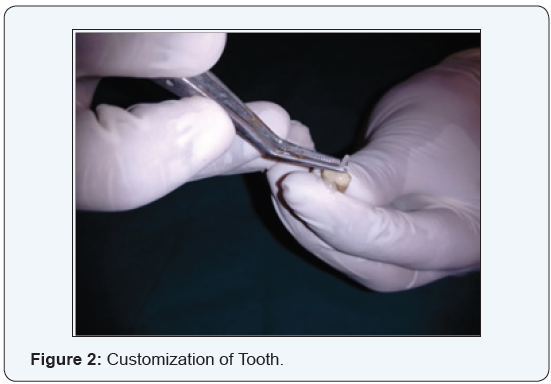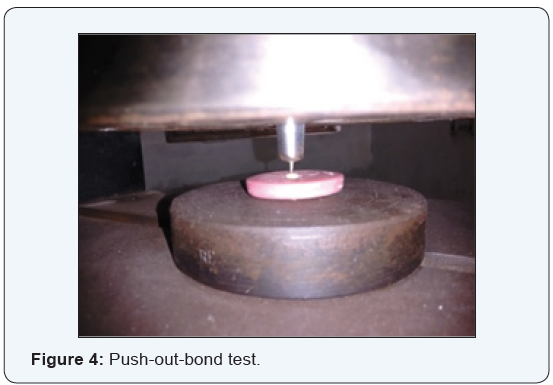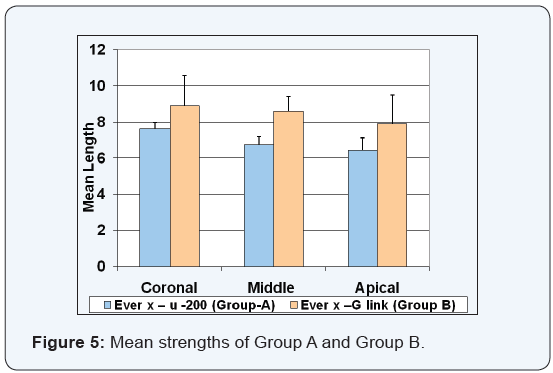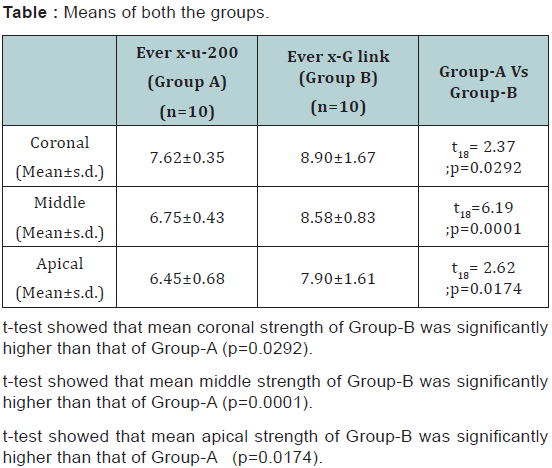Comparison of Push out Bond Strength of Customizable Fiber Post using two Self Adhesive Resin Cement-An In-Vitro Study
Priti Desai*, Anatava Maiti, Kaushik Dutta, U.K. Das2
West Bengal University of Health sciences, India
Submission: May 04, 2016; Published:May 26, 2016
*Corresponding author: Priti Desai, 4 G, Tiljala road, Shree apartment, Flat no-44; Kolkata, Pin code: 700046, West Bengal, India, Tel:09477075970; Email:drpriti111@gmail.com
How to cite this article: Priti D, Anatava M, Kaushik D, UK Das. Comparison of Push out Bond Strength of Customizable Fiber Post using two Self Adhesive Resin Cement-An In-Vitro Study. Adv Dent & Oral Health. 2016; 2(1): 555576. DOI: 10.19080/ADOH.2016.02.555576
Abstract
Materials and Methods: Twenty human mandibular single-rooted second premolar teeth were decoronated, endodontically treated, post space prepared and divided into two groups (n = 10); Group I: Everstick post (GC India) and U-200 resin cement(3M), Group II: Everstick post (GC) and G-cem Resin cement (GC). Each root was sectioned to get slices of 3 ± 0.1-mm thickness. Push-out tests were performed using a universal testing machine. To express bond strength in megapascals (Mpa), load value recorded in Newton (N) was divided by the area of the bonded interface.
Results: The mean values of the push-out bond strength show that Group II had significantly higher values than Group I in all three region of the root.
Conclusion: Within limitation of present study it can be concluded that customizable post shows good bond strength with respective resin cement from the same manufacturer.
Abbreviations: GC: G-cem Resin Cement; Mpa: Mega Pascals; N: Newton; FRC: Fiber-Reinforced Composite; SARCs: Self-Adhesive Resin Cements; IPN: Semi-Interpenetrating Polymer Network; PMMA: Polymethyl Methacrelate
Introduction
Endodontically treated teeth, with a large amount of coronal tooth structure missing, frequently require the placement of a post inside the root canal, to retain a core for definitive restoration. The choice of appropriate restoration for these teeth is influenced by strength and esthetics. Depending on the clinical parameters, the choice may be a metal or an esthetic post and core restoration. Fiber-reinforced composite (FRC) posts, as an alternative to cast post and cores and metal dowels, were introduced in the early 1990s to restore endodontically treated teeth with an excessive loss of tooth structure [1,2]. The popularity and preference for FRC posts can be chiefly ascribed because of an elastic modulus that is closer to that of dentin and provision of good esthetic particularly when all ceramic crowns are done [3]. Other advantages of FRC posts include enabling smooth cementation procedures to be carried out without friction with root canal walls and a reduced risk of root fractures [1-5]. Later on several advantages are shown in an in-vitro studies that FRC posts distribute occlusal stresses more evenly in the root dentin, thereby resulting in fewer and more favorable root fractures, which were often repairable [6-8].
When post and core restoration done in esthetic region of mouth, quartz or glass fiber posts can be used [9]. With regard to the fiber posts that are currently available on the market, they are composed of unidirectional fibers embedded in a resin matrix in which reinforcing quartz or glass fibers are immersed. Fibers are pre-stressed, and subsequently resin (as a filler) is injected under pressure to fill the spaces between the fibers, giving them solid cohesion [10,11]. Because of rigidity and poor adaptability of FRC post and more chances of debonding of fiber reinforced post recently customizable fiber post are introduce in market that are flexible during manipulation and rigid after light curing that makes them adopt well to root canal anatomy .e.g. Everex post, Peerless Post etc.
With the newly developed self-adhesive resin cements, no pre-treatment of dentin conditioning with the phosphoric acid is not required, so the step of rinsing off the phosphoric acid is also eliminated, and hence the need for clinical assessment of optimal dentin wetness after rinsing dentin [12]. In other words, the simpler self-etching adhesive approach requires a reduced number of clinical procedural steps, hence offering the advantages of a shorter adhesive application time and more importantly, reduced technique sensitivity. As for the bonding performance of self-adhesive resin cements when used to lute fiber posts, it has been assessed in in-vitro studies and compared against the performance of total-etching adhesive. However, findings on the performance of self-etching adhesives with regard to customized fiber post cementation were not consistent in literature search.
So here with we have done study to find push out bond strength of customized post with different self adhesive resin cement. The aim of the present study was to do comparative evaluation of the push-out bond strength of two new selfadhesive resin cements (SARCs) used for luting customizable glass fiber posts into root canals obturated with resin-based sealer (AH 26) and core material (Gutta-percha).
The null hypotheses tested were as follows:
Materials and Methods
Twenty human mandibular second pre-molars extracted for periodontal and orthodontic reasons were selected. The specimens were free of cracks, carious lesions, fractures, and resorption, with fully developed apices and without previous endodontic treatment. Teeth were cleansed using ultrasonic and disinfected by immersion in 2.5% sodium hypochlorite solution for 2hr and stored in normal saline (Figure 1). All the teeth were decoronated 1.5-2.0mm coronal to the cemento–enamel junction with a diamond disc to get 15 mm root length. The pulp tissue was extirpated and canal patency was assessed with a size 10 K-file. Working length was established 1 mm short of the apical foramen and canals were enlarged up to rotary protaper F3 file following the crown down technique with an intermittent irrigation using 1ml of 2.5% sodium hypochlorite. After final irrigation with normal saline, the canals were completely dried and obturated using AH plus sealer and corresponding F3 Guttapercha. Followed by temporary seal and stored for saline.

Post luting procedures according to adhesive approaches
For post space preparation, temporary seal and gutta-percha was removed with a warm plugger and peeso file no 3 (1.1mm diameter), leaving a minimum apical seal of 4−5 mm of guttapercha in the canal. Post holes were prepared up to a depth of 10mm from the CEJ. A final flushing of the canal space was accomplished using sterile water, and the canals were dried with paper points (Dentsply-Maillefer). The presence of any residual gutta-percha in the root canal walls along the post space was checked by radiographic evaluation. Customizable post were customized for each tooth before curing it according to shape of canal in each specimen (Figure 2). The prepared specimen roots were randomly divided into two groups: Group-1, Group-2. In group-1 the resin cement used was U-200 resin cement and in group-2 G-cem link ace resin cement were used. Before cementation all the specimen was cleaned, rinsed and the post space was thoroughly dried using paper points. Cementation is done with direct method means preshaped customized post (Everstick post, GC India) placed in canal after placing respective cement in specimen root and post and curing for both done together) using Automix Tip for Endo with extension tip which extrude material into root canal and post was insert immediately within 1min. excess cement was removed and light cure for 20sec was done. After curing specimen roots were stored in normal saline for 72 hours.

Push-out bond strength evaluation
To evaluate the push-out bond strength between the fiber posts and the luting cements, a thin-slice push-out test was used in this study. Each specimen was sectioned horizontally with a low-speed diamond disk (Isomet 1000, Buehler Ltd.) under water cooling to produce three 3±0.1 mm thick post-dentin sections from CEJ to apical third (cervical, middle, and apical) (Figure 3). The first slice represented the cervical region, the next slice represented middle region and the last slice represented the apical region of the prepared post space. None of the slices failed during sectioning, and all slices were used for push-out bond strength evaluation. Each specimen was marked on its coronal surface with an indelible marker, and the exact thickness of each slice was measured using a digital caliper (0.01 mm accuracy; Mitutoyo, Tokyo, Japan).

Each section was attached to a push-out jig with a cyanoacrylate adhesive (Zapit®, Dental Ventures of America Inc., Corona, CA, USA), whereby the coronal surface of root faced the jig and the post was centered over the hole of the jig. The post segment was loaded with a custom made jig (1mm in diameter), which was centered on the post segment and which had no contact with the surrounding dentin surface. Load was applied with a universal testing machine, in an apical-tocervical direction with respect to the individual test specimens, at a crosshead speed of 1mm/min until the post was dislodged (Figure 4). Push-out bond strength was measured in Kilo Newton converted to megapascals (MPa) for each specimen by using the following formula: (Table 1 & 2) (Figure 5).





Discussion
The success of endodontic therapy depends on adequate post endodontic restoration to make pulpless teeth function as an integral part of the masticatory apparatus. Pulpless teeth present various challenges of the restorative problems such as loss of tooth structure by caries or fracture and previously existing defective restorations. The introduction of the intracoronal post in endodontically treated teeth serves primarily to retain core structure and later coronal restoration. Many different types of posts have been used such as, cast metal alloy posts and prefabricated metal posts made of various alloys such as stainless steel and titanium. The cast post core system needs elaborate laboratory procedures and have rigidity due to its high modulus of elasticity and that is the major drawback of metal posts. Catastrophic root fractures have been attributed to these differences in the rigidity of the post and root dentine due to stress concentrations inside root leading to irreparable failures. In recent years, non-metallic posts with biological and physical properties similar to that of dentine have been introduced.
The advantages claimed for fiber posts are that post can be bonded to the tooth, and modulus of elasticity is close to that of dentin resulting in greater post flexibility. To preserve esthetics, fiber posts have been introduced, which are made of quartz and glass fibers embedded in a resin matrix. These posts are composed of unidirectional fiber and are becoming more popular because of their good bond strength to dentine and light transmission. An in-vitro study suggested that fiber posts are less likely to cause vertical root fracture as compared to stainless steel posts because forces are apparently absorbed by the post and core and not transferred to the root structure. The most common disadvantage of post cores is poor retention of posts, debonding is common problem. The post material, surface structure, post length cement, luting cement and amount of remaining tooth structure all affect retention of the post. In order to improve bond strength between the post and resin cement, many post surface pre-treatment procedures have been suggested regarding the use of mechanical or chemical agents [10].In-vitro studies regarding effect of cement on retention of post has been investigated extensively. Studies have shown that use of resin cement significantly increases retention and fracture resistance of tooth by providing adhesive bonding.
The retention of fiber posts in root canals is dependent upon adhesion between the resin cement and the dentine, as well as on adhesion between the resin cement and the posts. However, the adhesion between the resin cement and the dentine is considered to be the weak point in luting a fiber post [13]. Although bonding between the post and the root canal dentine plays a pivotal role in the long-term success of a restoration, ensuring reliable bonding between the post and the composite core is also necessary. If the bonding of that interface is poor, de-bonding and/or fracture of the core and post can occur [14]. Successful bonding minimizes the wedging effect of the post within the root canal and requires less dentine removal to accommodate a shorter and thinner post; in addition, it leads to lower susceptibility to tooth fracture [15]. Bonding to root canals might be difficult, because of the handling characteristics of the adhesive system, root anatomy, tooth position, the use of a light-curing technique, the experience and skill of the operators, etc [16].
Self-adhesive cements were introduced in 2002 as a new subgroup of resin cements [16]. They were designed with the intent of integrating the favorable characteristics of different cement classes into a single product [17]. Their main advantage is the simplicity of clinical use. These cements are expected to offer properties analogous to those of resin cements.
The results of this study require the rejection of the null hypothesis since differences in push-out bond strength exist between the tested self-adhesive cements. The bonding mechanism of self-adhesive cements rely on chemical interactions and micromechanical retentions with the bonding substrate, but concerns still exist on the effective adhesive potential of these simplified cements. In the present study, G-cem link ace attained higher bond strength values when compared to Rely X U-200. A variety of experimental tests has been described for evaluating the strength of the bond between the root canal dentine and the fiber posts, such as the pull-out test, the microtensile test, and the push-out test [18-20]. In the present study, the pushout test was performed using 1mm thick tooth slices, because this approach offers the advantage of smaller adhesive areas, which help to avoid the difficulties of microtensile specimen preparation. Cylindrical or conical fiber posts may be used in the push-out test procedure. In both cases, the result is a complex stress distributed at the interface between the dentine and the resin cement and between the post and the cement with a shear stress component [20]. Cylindrical posts used in the push-out test have been reported in some studies to increase the risk of friction [21]. Conical fiber posts with a shape more appropriate for root canal preparation will eliminate some of the friction between the resin cement and the post from the push-out test. This is why customizable fibre post (Everex Fiber Post) was used in the present study for evaluation of the push-out bond strength.
In both groups coronal bond strength was higher than middle third and middle third has higher bond strength value than apical third. Our result was in agreement with the previous studies that reported higher bond strength for coronal dentin than values for the middle and apical sections of the root. Prefabricated post are made up of highly cross link polymer matrix between fiber because of high conversation rate they should be more or less non reactiven therefore bonding between prefabricted post and adhesive luting agent can be hamphered. Recently developed FRC post consisit of continous unidirectional glass fibres and multiphase polymer matrix. This polymer matrix reveals a semi-interpenetrating polymer network(IPN) with both linear polymer phases, polymethyl methacrelate(PMMA) and cross link polymer phase. Monomer of adhesive resin penetrate in to the linear phases and form an interdifusion bonding by polymerization [22].
Kerstin Bitter et al. [23,24] in 2007 done study investigated bond strength of ever stick post with different resine cement using push out model. Type of post and cemtent used has signifcant effect on bond stregth of fiber reinforced post. IPN everstick post shows good bond stregnth compared to prefabrcated post. The surface of prefabricated fiber post with cross link matrix has very small amount of reactivity is left for free radical polymerization and bonding,lead to lower bond stregnth with prefabicated FRC post than customizsed FRC post. In customised post linear (PMMA) and cross link phases both are present, linear phase is penetrated ny Bis pheno-A glycidyl methacrylate of resin cement and inter difussion bonding is established, lead to high bond stregnth of everstick post. Failure mode between prefabricated FRC post and customised post is found poor adhesion between resin cement and post.post composite bond is poor rather than resin cement or post itself. Type of Resin ceement used significantly affect the bond strenght of FRC post but type of post use has more influence on the bond stregnth of post [23].
There are two types of technique are used for cementation of FRC post, indirect (post is cure before cementation and direct technique (post and resin cemented cure together). The “direct technique” seems to be beneficial when cementing individually formed FRC posts than indirect technique (polymerized before cementation). Bonding of a FRC root canal post to a root depends on the adhesion of luting cement to the post and to the root canal dentin [24]. According to Davis et al. [25] the flexural strength of the Stick Tech post was significantly lower than the flexural strength of the GC post. The mode of failure for the GC Posts was adhesive, whereas the Stick Tech posts failed cohesively. Different flexural strengths and failure modes were observed among the two fiber post-resin systems [25].
Conclusion
Within limitation of the study it can be concluded that the post system and resin cement should be used from same manufacture company.
References
- Duret B, Reynaud M, Duret F (1990) New concept of coronoradicular reconstruction: the Composipost (1). Chir Dent Fr 60(540): 131-141.
- Asmussen E, Peutzfeldt A, Heitmann T (1999) Stiffness, elastic limit, and strength of newer types of endodontic posts. J Dent 27(4): 275- 278.
- Torbjörner A, Karlsson S, Odman PA (1995) Survival rate and failure characteristics for two post designs. J Prosthet Dent 73(5): 439-444.
- Trope M, Maltz DO, Tronstad L (1985) Resistance to fracture of restored endodontically treated teeth. Endod Dent Traumatol 1(3): 108-111.
- Sirimai S, Riis DN, Morgano SM (1999) An in vitro study of the fracture resistance and the incidence of vertical root fracture of pulpless teeth restored with six post-and-core systems. J Prosthet Dent 81(3): 262- 269.
- G.Bateman, DNJ Ricketts, WP Saunders (2003) Fibre-based post systems: a review. Br Dent J 195(1): 43-48.
- Schwartz RS, Robbins JW (2004) Post placement and restoration of endodontically treated teeth: a literature review. J Endod 30(5): 289- 301.
- Fokkinga WA, Kreulen CM, Vallittu PK, Creugers NH (2004) A structured analysis of in vitro failure loads and failure modes of fiber, metal and ceramic post-and-core systems. Int J Prosthodont 17(4): 476-482.
- Vichi A, Ferrari M, Davidson CL (2000) Influence of ceramic and cement thickness on the masking of various type of opaque posts. J Prosthet Dent 83(4): 412-417.
- Grandini S, Goracci C, Monticelli F, Tay FR, Ferrari M (2005) Fatigue resistance and structural characteristics of fiber posts: three-point bending test and SEM evaluation. Dent Mater 21(2): 75-82.
- Perdigão J, Gomes G, Augusto V (2007) The effect of dowel space on the bond strengths of fiber posts. J Prosthodont 16(3): 154-164.
- Van Meerbeek B, De Munck J, Yoshida Y, Inoue S, Vargas M, et al. (2003) Adhesion to enamel and dentin: current status and future challenges. Oper Dent 28(3): 215-235.
- Goracci C, Tavares AU, Fabianelli A, Monticelli F, Raffaelli O, et al. (2004) The adhesion between fiber posts and root canal walls: comparison between microtensile and push-out bond strength measurements. Eur J Oral Sci 112(4): 353-361.
- De Santis R, Prisco D, Apicella A, Ambrosio L, Rengo S, et al. (2000) Carbon fiber post adhesion to resin luting cement in the restoration of endodontically treated teeth. J Mater Sci Mater Med 11(4): 201-206.
- Vano M, Cury AH, Goracci C, Chieffi N, Gabriele M, et al. (2008) Retention of fiber posts cemented at different time intervals in canals obturated using an epoxy resin sealer. J Dent 36(10): 801-807.
- Magni E, Mazzitelli C, Papacchini F, Radovic I, Goracci C, et al. (2007) Adhesion between fiber posts and resin luting agents: a microtensile bond strength test and an SEM investigation following different treatments of the post surface. J Adhes Dent 9(2): 195-202.
- Goracci C, Tavares AU, Fabianelli A, Monticelli F, Raffaelli O, et al. (2004) The adhesion between fiber posts and root canal walls: comparison between microtensile and push-out bond strength measurements. Eur J Oral Sci 112(4): 353-361.
- Bitter K, Meyer-Lueckel H, Priehn K, Kanjuparambil JP, Neumann K, et al. (2006) Effects of luting agent and thermocycling on bond strengths to root canal dentine. Int Endod J 39(10): 809-818.
- De Santis R, Prisco D, Apicella A, Ambrosio L, Rengo S, et al. (2000) Carbon fiber post adhesion to resin luting cement in the restoration of endodontically treated teeth. J Mater Sci Mater Med 11(4): 201-206.
- Vano M, Cury AH, Goracci C, Chieffi N, Gabriele M, et al. (2008) Retention of fiber posts cemented at different time intervals in canals obturated using an epoxy resin sealer. J Dent 36(10): 801-807.
- Davis P, Melo LS, Foxton RM, Sherriff M, Pilecki P, et al. (2010) Flexural strength of glass fibre-reinforced posts bonded to dual-cure composite resin cements. Eur J Oral Sci 118(2): 197-201.
- Bitter K, Meyer-Lueckel H, Priehn K, Kanjuparambil JP, Neumann K, et al. (2006) Effects of luting agent and thermocycling on bond strengths to root canal dentine. Int Endod J 39(10): 809-818.
- Bitter K, Noetzel J, Neumann K, Kielbassa AM (2007) Effect of silanizationon bond strength of fiber posts to various resin cement. Quintessence Int 38(2): 121-128.
- Bitter K, Noetzel J, Neumann K, Kielbassa AM (2007) Effect of silanizationon bond strength of fiber posts to various resin cement. Quintessence Int 38(2): 121-128.
- Makarewicz D, Le Bell-Rönnlöf AM, Lassila LV, Vallittu PK (2013) Effect of Cementation Technique of Individually Formed Fiber-Reinforced Composite Post on Bond Strength and Microleakage. Open Dent J 7: 68-75.






























